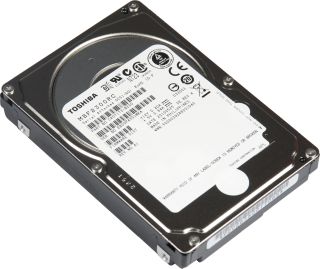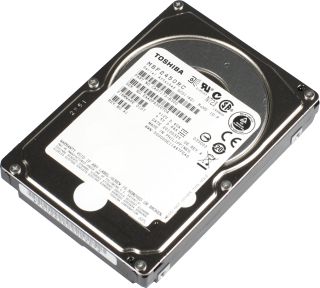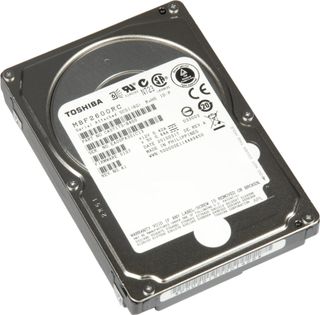Analysis: Which Enterprise Capacity Point Performs Best?
SSDs are best for performance. SATA hard drives provide maximum capacity. Enterprise-class SAS disks are the workhorses positioned between them. But which enterprise hard drive capacity makes sense when there are several from which to choose?
300GB, 450GB, And 600GB Models Compared
300GB: MBF2300RC

Toshiba's 300GB version is the company's cheapest option for a 2.5” SAS 6 Gb/s drive at 10,000 RPM. It's based on two physical platters and three read/write heads, meaning that one side of one platter isn’t utilized on this drive. We found that this has an impact on performance, as the 300GB drive is the one that delivers the highest throughput results (almost 150 MB/s) while the others hit limits at 143 and 147 MB/s.
More importantly, minimum throughput stays above 95 MB/s at all times, while the two competitors drop to 92.4 and 87.7 MB/s for reads and a bit less on writes. At the same time, the two other capacities provide slightly better I/O performance and also slightly increased application performance in PCMark Vantage.


450GB: MBF2450RC

The 450GB drive is based on three platters, but it only utilizes five out of six platter surfaces, and hence only five read/write heads. It is neither the fastest on throughput nor on maximum I/Os. The main disadvantage is that it is based on three platters, which impacts power consumption but doesn’t ratchet up peak performance in any discipline. As a result, power efficiency on streaming reads is better on the two other drives, while the 450GB unit's efficiency on I/Os is in between the two others. Generally, this drive is somewhat stuck in limbo.


600GB: MBF2600RC

We already looked at this drive when we compared it to Seagate’s Savvio 10K.4 drive. It outperforms the Seagate drive on enterprise workloads, and it fares better in our power consumption tests. Compared to its siblings at 300GB and 450GB, the largest drive provides almost the same throughput numbers as the 300GB product and equal or higher I/O performance. We also found that it has the highest overall score in PCMark Vantage, a general PC application benchmark. The 600GB drive doesn’t manage to dominate performance per watt in throughput or I/O performance, but it is still the top choice if you’re looking for best capacity per watt.
Stay on the Cutting Edge
Join the experts who read Tom's Hardware for the inside track on enthusiast PC tech news — and have for over 25 years. We'll send breaking news and in-depth reviews of CPUs, GPUs, AI, maker hardware and more straight to your inbox.


Current page: 300GB, 450GB, And 600GB Models Compared
Prev Page 2.5” And 10,000 RPM: The Toshiba MBF2xxxRC Family Next Page Test Setup And Comparison Table